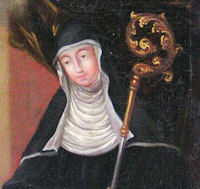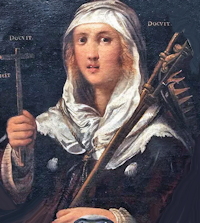Ordinary Time: February 25th
Friday of the Seventh Week in Ordinary Time
Other Commemorations: St. Walburga, Abbess (RM)
» Enjoy our Liturgical Seasons series of e-books!
Today The Roman Martyrology commemorates St. Walburga, abbess, who, at the request of St. Boniface and her holy brothers Sts. Willibald and Winebald, left England to come to Germany to help establish the faith there. She established a double monastery of monks and nuns at Hiedenhem, where she was abbess. She died February 25, 779, and later her relics were translated to Eichstatt on May 1, 870.
St. Walburga
St. Walburga was born around 710. She is the daughter of St. Richard and the niece of St. Boniface. When St. Richard set out for a pilgrimage to the Holy Land with his sons, Ss. Willibald & Winibald, he entrusted 11 year old Walburga to the monastery school at Wimborne. She remained as a nun, spending a total of 26 years there.
 When St. Boniface put out an appeal for nuns to help him in the evangelization of Germany, St. Walburga answered the call. On the way to Germany, there was a terrible storm at sea. Walburga knelt on the deck of the ship and prayed. The sea immediately became calm. Some sailors witnessed this and spread the word that she was a wonderworker, so she was received in Germany with great respect.
When St. Boniface put out an appeal for nuns to help him in the evangelization of Germany, St. Walburga answered the call. On the way to Germany, there was a terrible storm at sea. Walburga knelt on the deck of the ship and prayed. The sea immediately became calm. Some sailors witnessed this and spread the word that she was a wonderworker, so she was received in Germany with great respect.
At first, she lived at Bischofsheim, under the rule of St. Lioba. Then she was made abbess at Heidenheim, near to where her brother, Winibald served as an abbot over a men's monastery. After his death, she ruled both monasteries. She worked many miracles in the course of her ministry. She wrote a biography of her brother, Winibald, and of Willibald's travels in Palestine, in Latin. She is regarded as the first woman author in both England and Germany.
On September 23, 776, she assisted Willibald in translating the uncorrupt relics of their brother, Winibald, to a new tomb in the church at Heidenheim. Shortly after this, she fell ill. Willibald cared for her until she died on February 25, 777, then placed her next to Winibald in the tomb.
After St. Willibald's death in 786, people gradually forgot St. Walburga and the church fell into disrepair. In 870, Bishop Oktar was having Heidenheim restored. Some workmen desecrated Walburga's grave. She appeared in a dream to the bishop, who then translated her relics to Eichstadt. In 893, St. Walburga's body was found to be immersed in a mysterious sweet-smelling liquid. It was found to work miraculous healings. The liquid, called St. Walburga's oil, has flowed from her body, ever since, except for a brief period when the church was put under the interdict after robbers shed the blood of a bell-ringer in the church. Portions of St. Walburga's relics have taken to several other cities and her oil to all parts of the world.
Patronage: against coughs; against dog bites; against famine; against hydrophobia; against mad dogs; against plague; against rabies; against storms; boatmen; farmers; harvests; mariners; sailors; watermen; diocese of Eichstätt, Germany; diocese of Plymouth, England; Antwerp, Belgium; Gronigen, Netherlands; Oudenarde, Belgium; Zutphen, Netherlands
Symbols and Representation: abbess holding three ears of corn; abbess with angels holding a crown over her; abbess within a family tree of the kings of England; crown; near her own tomb as it exudes its miraculous oil
phial of oil; royal abbess with a small flask of oil on a book; scepter; three ears of corn; with Saint Willibald and Saint Winebald
Highlights and Things to Do:
- Eliminating Confusion: The night of 1 May, the date of the translation of Walburga’s relics to Eichstatt in 870, is known as Walpurgisnacht (or St. Walburga's Eve); it is also a pagan festival marking the beginning of summer and the revels of witches. Though the saint had no connection with this festival, her name became associated with witchcraft and country superstitions because of the date. It is possible that the protection of crops ascribed to her, represented by three ears of corn in her icons, may have been transferred to her from Mother Earth and the connection to this pagan holiday. (From CatholicSaints.Info).
- Read more about St. Walburga:
- Visit online two of the American abbeys dedicated to St. Walburga: in Northern Colorado and St. Emma Monastery in Greensburg, Pennsylvania.
- Read more about the Oil of St. Walburga. This is the church in Eichstädt in Bavaria, Germany where her body and the oil is found.






